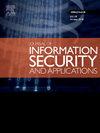Reversible data hiding in encrypted image using bit-plane based label-map encoding with optimal block size
IF 3.8
2区 计算机科学
Q2 COMPUTER SCIENCE, INFORMATION SYSTEMS
Journal of Information Security and Applications
Pub Date : 2025-02-24
DOI:10.1016/j.jisa.2025.104005
引用次数: 0
Abstract
In today’s digital landscape, maintaining the confidentiality and privacy of sensitive information has become an essential requirement. For this, Reversible data hiding in encrypted images (RDHEI) has garnered considerable attention as it enables embedding of large amounts of secret data in encrypted images without requiring knowledge of the original image contents. To further increase the embedding capacity (EC) while maintaining security, this paper presents a new bit-plane-based RDHEI using label-map encoding with optimal block size. The proposed method employs a hybrid predictor to generate a low-magnitude difference image, which is transformed into highly compressible bit-plane-wise label-maps. A novel block-based label-map encoding is also introduced, which optimally represents these label-maps as bit-streams to significantly reduce their size. These bit-streams are embedded in the original encrypted image to guide the data hider, ensuring complete reversibility and lossless extraction at the receiving end. Extensive experimentation shows that the proposed method achieves an average embedding rate of 3.8770 bpp for BOSSBase and 3.7944 bpp for BOWS-2, outperforming state-of-the-art RDHEI methods. Further, the method ensures lossless reconstruction of the original image and error-free extraction of hidden data while demonstrating strong resilience against malicious attacks.
使用最优块大小的基于位平面的标签映射编码在加密图像中隐藏可逆数据
在当今的数字环境中,保持敏感信息的保密性和隐私性已成为一项基本要求。因此,隐藏在加密图像中的可逆数据(RDHEI)已经引起了相当大的关注,因为它可以在不需要了解原始图像内容的情况下将大量秘密数据嵌入加密图像中。为了在保证安全性的同时进一步提高嵌入容量,本文提出了一种新的基于位平面的rdhi,该rdhi采用最优块大小的标签映射编码。该方法采用混合预测器生成低幅度差图像,并将其转换为高度可压缩的位平面标记图。本文还介绍了一种新的基于块的标签映射编码,该编码将这些标签映射最佳地表示为位流,从而大大减小了标签映射的大小。这些比特流嵌入到原始加密图像中,引导数据隐藏器,确保接收端的完全可逆性和无损提取。大量实验表明,该方法在BOSSBase和BOWS-2的平均嵌入率分别为3.8770 bpp和3.7944 bpp,优于目前最先进的RDHEI方法。此外,该方法确保了原始图像的无损重建和隐藏数据的无错误提取,同时对恶意攻击表现出强大的恢复能力。
本文章由计算机程序翻译,如有差异,请以英文原文为准。
求助全文
约1分钟内获得全文
求助全文
来源期刊

Journal of Information Security and Applications
Computer Science-Computer Networks and Communications
CiteScore
10.90
自引率
5.40%
发文量
206
审稿时长
56 days
期刊介绍:
Journal of Information Security and Applications (JISA) focuses on the original research and practice-driven applications with relevance to information security and applications. JISA provides a common linkage between a vibrant scientific and research community and industry professionals by offering a clear view on modern problems and challenges in information security, as well as identifying promising scientific and "best-practice" solutions. JISA issues offer a balance between original research work and innovative industrial approaches by internationally renowned information security experts and researchers.
 求助内容:
求助内容: 应助结果提醒方式:
应助结果提醒方式:


